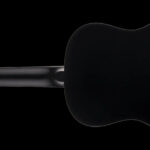For guitar players venturing into recording, a Guitar Audio Interface is an indispensable piece of gear. At its core, an audio interface acts as the bridge between your guitar and your computer, transforming your instrument’s analog signal into a digital format that your recording software can understand, and vice versa. But a quality interface is much more than a simple converter; it’s the key to unlocking professional-sounding recordings and enhancing your overall playing experience.
Understanding the Basics: AD/DA Conversion and Beyond
The primary function of any guitar audio interface is Analog-to-Digital (AD) and Digital-to-Analog (DA) conversion. This process translates the analog signal from your guitar into digital data for your computer to process and then converts the digital audio back into an analog signal you can hear through your speakers or headphones. Better interfaces utilize high-quality converters, often featuring “jitter correction” technology. Jitter refers to timing inconsistencies in the digital signal, and correcting it leads to a cleaner, more accurate audio representation.
However, modern guitar audio interfaces are far more versatile than basic converters. They typically incorporate:
- Mic Preamps: Essential for recording acoustic guitars or amplifiers using microphones. Preamps boost the microphone signal to a usable level for recording, and higher quality preamps contribute significantly to a cleaner and more detailed sound.
- Multiple Inputs and Outputs (I/O): Allow you to connect various instruments, microphones, and monitors simultaneously. Common configurations range from basic 2-in/2-out interfaces for solo recording to larger interfaces with 18 inputs or more for complex setups. These connections can be balanced (TRS or XLR) for reduced noise or unbalanced (TS). Digital I/O options like S/PDIF or ADAT further expand connectivity.
- Onboard DSP (Digital Signal Processing): Some interfaces include internal DSP for real-time effects like reverb, EQ, and compression. This is particularly beneficial for monitoring purposes, allowing you to hear effects while recording without taxing your computer’s CPU or introducing latency.
The Importance of Quality Components: Op-Amps and More
The sonic quality of a guitar audio interface is heavily influenced by the quality of its internal components, particularly operational amplifiers (op-amps). High-end interfaces employ premium op-amps known for their low noise and minimal distortion. Some even utilize discrete components instead of integrated circuits for even greater sonic purity. Investing in an interface with superior components translates directly to cleaner recordings with greater dynamic range and clarity, capturing the nuances of your guitar playing.
Input and Output Needs: Tailoring to Your Setup
The number of inputs and outputs you require in a guitar audio interface depends on your recording needs.
- Basic 2-in/2-out interfaces are suitable for solo guitarists recording directly or miking a single amplifier. They can also handle stereo microphone setups for acoustic guitars or small ensembles.
- Interfaces with 4-8 inputs offer more flexibility for recording multiple instruments simultaneously, miking drum kits, or recording a band in a home studio setting.
- Larger interfaces with 18 inputs and beyond are designed for professional studios and complex recording scenarios demanding numerous channels.
Consider your current and future recording aspirations when choosing the number of I/O connections.
Connectivity Options: USB, Thunderbolt, and More
Connecting your guitar audio interface to your computer involves different interface protocols, each with its own advantages:
- USB: The most common and versatile connection type. USB interfaces are generally compact, bus-powered (drawing power from the USB port), and compatible with both Windows and macOS. USB interfaces are ideal for home studios and mobile recording.
- Thunderbolt: Offers significantly faster data transfer speeds and lower latency compared to USB. Thunderbolt interfaces are favored in professional studios and for demanding applications requiring high channel counts and low latency performance. They are primarily found on macOS systems, though compatibility is expanding to Windows.
- PCIe: Internal cards that install directly into a desktop computer’s PCIe slot. PCIe interfaces offer the highest bandwidth and lowest latency but are limited to desktop setups.
- FireWire (IEEE 1394): An older standard that was once popular for audio interfaces. While still functional, FireWire is less common now, with USB and Thunderbolt becoming the dominant options.
For guitarists, both USB and Thunderbolt interfaces are excellent choices. USB offers broad compatibility and convenience, while Thunderbolt provides superior performance for demanding recording projects.
Popular Brands and Finding the Right Interface
Numerous reputable brands produce high-quality guitar audio interfaces, including Focusrite, Universal Audio, Apogee, PreSonus, Steinberg, MOTU, and Audient. Each brand offers a range of interfaces catering to different budgets and needs.
To find the best guitar audio interface for you, consider:
- Your budget: Interfaces range from entry-level models to high-end professional units.
- Your recording needs: Determine the number of inputs and outputs you require, the importance of mic preamps, and desired connectivity.
- Your computer system: Ensure compatibility with USB or Thunderbolt and consider the performance capabilities of your computer.
Consulting with pro audio specialists can provide valuable guidance in selecting the perfect guitar audio interface to elevate your guitar recordings and sonic possibilities.

